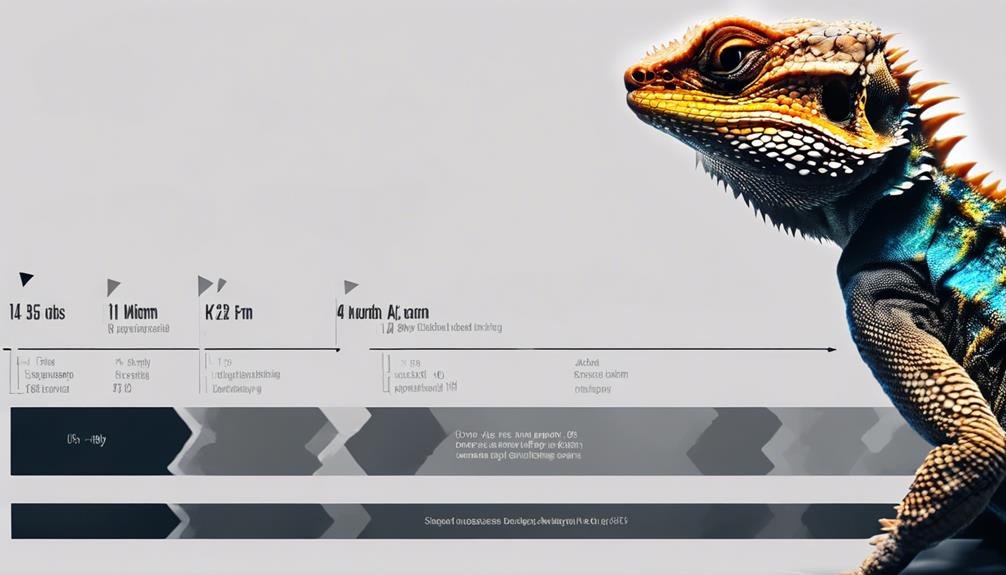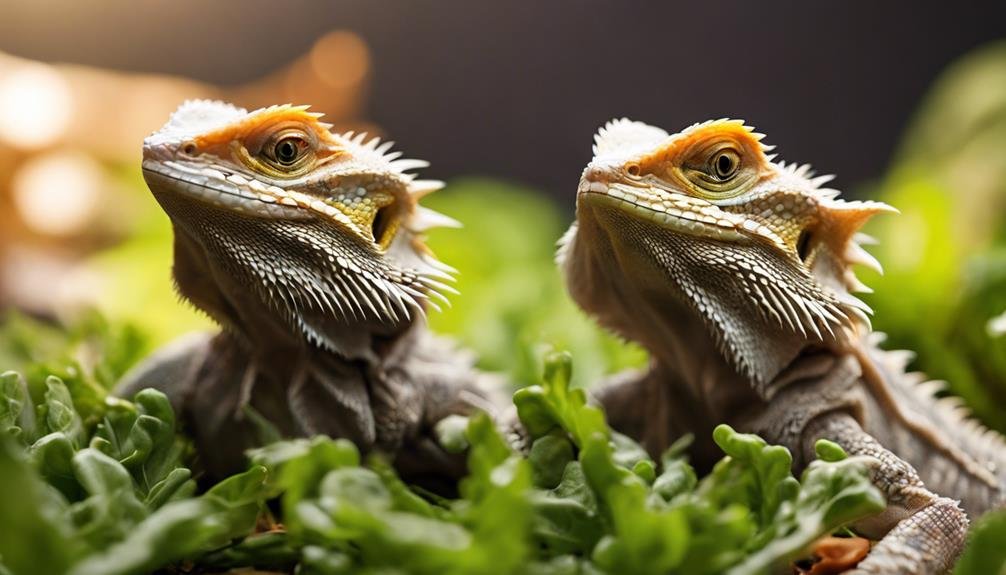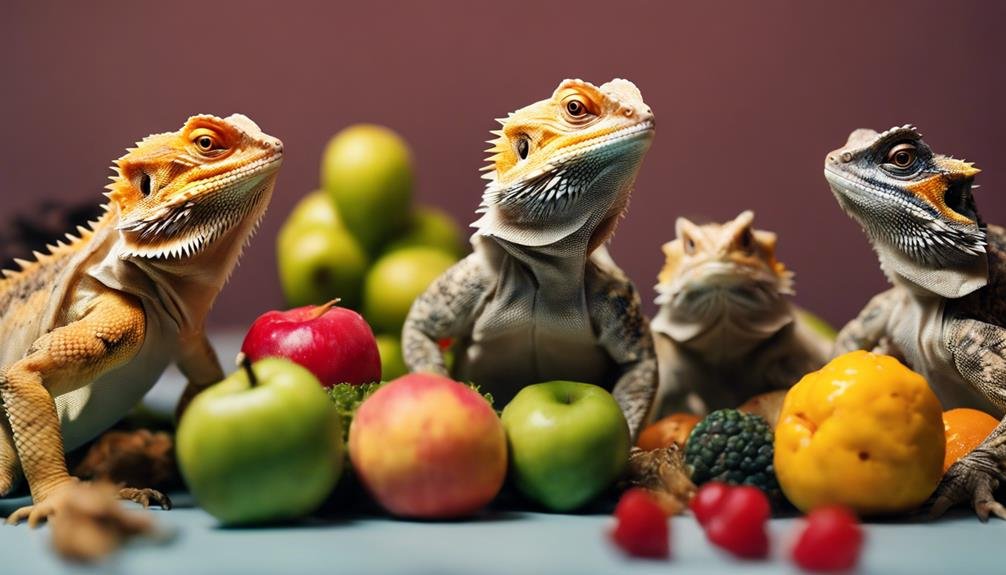If you've recently welcomed a bearded dragon into your life, you're likely curious about how quickly they'll grow and how their diet affects their growth rate. You'll find that during the first six months, they experience noteworthy growth spurts, which can be fascinating to observe. However, to guarantee they're growing at a healthy rate, you'll need to carefully manage their diet, which varies greatly from juveniles to adults. But how do you determine the right feeding quantities and frequency? And what impact does this have on their overall well-being? Let's explore the critical balance between nutrition and growth, and why understanding this dynamic is key to nurturing a healthy, thriving bearded dragon.
Key Takeaways
- Bearded dragons experience rapid growth, often reaching up to 12 inches in their first year.
- Growth rates vary based on genetics, diet, and environmental conditions.
- Juveniles require high-protein diets with 2-3 feedings per day for optimal growth.
- Monitoring and adjusting feeding quantities based on size and growth rate are essential.
- Regularly measuring from snout to tail and adjusting habitat size are crucial for healthy development.
Understanding Growth Phases
To guarantee your bearded dragon thrives, it's important to comprehend their growth phases, particularly as they undergo rapid spurts in the first 6 months. When you bring home a newborn bearded dragon, you're welcoming a small and delicate creature that needs a little bit more than just love. They grow quickly, and Sam and Ella's journey to reaching a significant size by 6 months is a common tale among bearded dragon owners. However, not all bearded dragons grow at the same pace. Their growth rates can vary widely, heavily influenced by genetics and the level of care they receive.
To make sure your bearded dragon is on the right track, monitoring their growth becomes a vital task. This isn't just about marking their size increase on a chart; it's about understanding what each growth phase means for their care requirements. As they grow, their needs change, particularly regarding feeding quantities and tank size. A proper understanding of these growth phases ensures that you're not only providing enough food but also adjusting their living space to accommodate their size. It's your job to adapt as they grow, ensuring they've everything they need to develop into healthy, happy bearded dragons.
Initial Growth Spurt Details
Understanding your bearded dragon's initial growth spurt is important as they'll undergo a significant transformation from birth to 6 months old. Initially, your pet might seem small and fragile, requiring special care to make sure they thrive. It's a critical period where they're not just growing in size but also in health and personality.
Imagine your bearded dragons, Sam and Ella, starting off so tiny, only to find them noticeably larger at 6 months old. This rapid growth is a clear indicator of their health and the effectiveness of their care routine. To accommodate this quick growth, starting with a larger tank is essential. You might think a small tank is suitable at first, but they'll quickly outgrow it. Bearded dragons can outgrow smaller tanks within a few months, making it necessary to upgrade their habitat to guarantee their well-being.
Yearly Growth Expectations


After the initial growth spurt, you'll find that your bearded dragon may grow up to 12 inches in their first year, with noticeable changes each month. This period is important as growth rate variations can be significant, influenced heavily by environmental factors and the care you provide. A well-maintained habitat with appropriate heat, light, and space is essential for supporting these growth spurts.
Genetic influences also play a role in how your bearded dragon grows. Some may naturally be larger or grow faster than others, indicating that not all growth patterns will be identical. Observing your pet's development closely will help you understand its unique growth trajectory.
Nutrition effects can't be overstated during this time. A diet rich in necessary nutrients will support healthy and steady growth. Young bearded dragons need a diet that's higher in protein to fuel their rapid growth, so ensuring they've access to proper feed is imperative. Remember, while growth spurts are expected, maintaining a balance of proper nutrition, spacious living conditions, and ideal environmental factors will guide your bearded dragon through its yearly growth expectations seamlessly.
Adult Size Predictions
Understanding how your bearded dragon will grow into its adult size is essential for its care.
You'll see how factors such as age, diet, and genetics play a role in predicting their final length.
Let's explore how these elements impact your pet's growth and what you can expect as they mature.
Predicting Final Length
To predict the final length of your bearded dragon, consider factors like genetics, diet, and environment which play pivotal roles in their growth. Bearded dragons can reach adult lengths of 18-24 inches, with males generally larger. Growth rate analysis is essential; juvenile bearded dragons might grow about 1 inch per month during their rapid growth phase.
With length projection, monitoring these growth milestones is key. Size estimation techniques also rely on observing how well your pet responds to proper nutrition and adequate space, both of which greatly influence their final size. Remember, while genetics set the potential, the care you provide can make a big difference in whether your bearded dragon reaches the upper end of the size spectrum.
Age Vs. Size Correlation
You'll find that the size your bearded dragon reaches by 12 to 18 months strongly correlates with their age, influenced by their genetics, diet, and living conditions. Understanding the growth patterns of these fascinating reptiles is essential in anticipating how big your pet might get. Typically, they'll grow to measure between 18 to 24 inches in length, hitting several size milestones along the way.
These milestones are critical indicators of their development stages, ensuring they're on track to reaching their full potential. By keeping a close eye on these growth indicators, you're better equipped to provide the care needed for their well-being.
Impact of Diet
Now that we've explored how age and size correlate, let's examine how diet profoundly influences a bearded dragon's growth and eventual adult size. A diet rich in protein sources and adequate calcium intake is vital for healthy development. Feeding your juvenile bearded dragon two to three times a day with these nutrients supports their rapid growth phase.
However, it's important to monitor not just what they eat, but how much. Overfeeding can lead to obesity, while underfeeding might stunt their growth. Including growth supplements appropriately can also play a role in achieving best growth rates.
Feeding for Optimal Growth
Ensuring your bearded dragon receives a high-protein diet through live insects like crickets, roaches, and mealworms is essential for their ideal growth. To keep up with their rapid growth rate, juvenile bearded dragons require feeding 2-3 times a day with prey items that are the right size for them. This frequent feeding schedule supports their developmental needs, providing the protein sources necessary for their growth.
Achieving a nutritional balance is key. Introducing a variety of foods ensures your bearded dragon gets all the necessary nutrients, helping to prevent any nutritional deficiencies that could impede their growth. Monitoring their size and age allows you to adjust feeding quantities, ensuring they're receiving just the right amount of food for healthy development. It's not just about how much they eat, but also the quality and variety of their diet that contributes to their overall well-being.
Size expectations and feeding habits are closely linked. As your bearded dragon grows, you'll need to adjust their diet to match their changing nutritional needs. Keeping an eye on their body condition and adjusting their feeding amounts accordingly can help prevent overfeeding or underfeeding, which is vital for maintaining optimal growth and health.
Impact of Diet Variations


The diet you provide plays an essential role in shaping the growth and health of your bearded dragon. By understanding the impact of diet variations, you can tailor your pet's meals to support their development effectively. Feeding variations directly correlate with growth outcomes; hence, it's important to strike a balance between the amount and type of food you offer. Younger dragons thrive on a protein-rich diet to fuel their rapid growth, while adults benefit from a more varied diet that supports maintaining their health rather than growth.
Achieving nutritional balance is key to optimizing growth rates. A diet that alternates between vegetables, insects, and the occasional fruit ensures that your bearded dragon receives all the necessary vitamins and minerals. Overfeeding leads to obesity and related health issues, whereas underfeeding can stunt growth and weaken the immune system.
Furthermore, diet diversity is essential for healthy growth development. A monotonous diet can result in nutritional deficiencies, affecting your dragon's vitality and growth. By offering a range of foods, you're not only catering to their nutritional needs but also encouraging natural foraging behaviors, which is beneficial for their mental health. Remember, the goal is to mirror their wild diet as closely as possible to support their overall well-being.
Monitoring Growth Progress
Once you've got a handle on your bearded dragon's diet, it's essential to start monitoring their growth progress. You'll learn about initial measurement techniques to accurately gauge their size and then track their monthly growth to spot any significant changes.
Adjusting feeding strategies based on this data guarantees your dragon remains on a healthy development trajectory.
Initial Measurement Techniques
To accurately track your bearded dragon's growth, measure from its snout to the tip of its tail using a soft measuring tape or ruler. This initial step is essential for establishing a baseline to monitor growth milestones. By employing consistent measuring techniques, you can detect growth rate variations and identify growth spurts, ensuring your dragon is developing at a healthy pace.
It's important to record these measurements regularly. This data becomes invaluable when charting your dragon's growth over time. Utilizing growth charting and comparison techniques allows you to visually track progress and compare it against typical growth patterns for bearded dragons. This method not only highlights your pet's growth trends but also alerts you to any potential health issues that may affect its growth.
Monthly Growth Tracking
How can you guarantee your bearded dragon is growing healthily? Regular monthly growth tracking is key. Observing growth patterns and ensuring proper nutrition can be achieved by:
- Measuring Length: Record your dragon's length to catch any growth spurts, indicating healthy development.
- Weighing: Implement weekly weight tracking to monitor health through consistent gains of 1-3 grams.
- Noting Body Changes: Changes in body proportions, like tail length and body mass, can signal important size milestones.
- Reviewing Diet: Assess if nutritional needs are met to support growth patterns and overall health monitoring.
This methodical approach to monthly growth tracking allows you to understand your bearded dragon's unique growth trajectory, ensuring they're hitting the right size milestones for their age and species.
Adjusting Feeding Strategies
After closely monitoring your bearded dragon's growth, it's important to adjust their feeding strategies to match their development needs. Keeping track of their size and weight regularly allows you to tweak feeding quantities to avoid over or underfeeding. It's essential to maintain a consistent feeding schedule that supports their growth and maintains a nutritional balance.
Consult a vet or reptile specialist for tailored advice as your dragon grows. Additionally, maintaining a growth journal can be invaluable for these adjustments.
| Growth Rate | Feeding Frequency |
|---|---|
| Rapid Growth | Increase |
| Steady Growth | Maintain Consistent |
| Slow Growth | Evaluate & Adjust |
Adjusting feeding strategies based on their growth rate ensures your bearded dragon stays healthy and thrives.
Adjusting Habitat for Growth
As your bearded dragon grows, it's important to upgrade their tank size in order to guarantee their environment supports their health and happiness. Bearded dragons experience rapid growth, which necessitates frequent habitat expansions to match their size and activity level. Starting with at least a 40-gallon breeder tank is advisable, but remember, as they grow, their need for space grows too.
To make sure your bearded dragon's environment aligns with their growth stages and promotes best health, consider the following steps:
- Monitor Growth Closely: Keep an eye on your dragon's growth rate to anticipate when a tank upgrade is necessary.
- Upgrade Tank Size: Shift to larger tanks as your dragon grows. A tank that's too small can hinder their development and well-being.
- Adjust Habitat Layout: As you increase the tank size, also enhance the habitat with larger basking spots, hides, and climbing opportunities suitable for their size.
- Plan for Future Growth: Understanding that bearded dragons outgrow their tanks within months, plan ahead for habitat expansions to avoid overcrowding and stress.
Can Bearded Dragons’ Growth Rate Affect Their Appetite and Food Intake?
Bearded dragon feeding habits can be affected by their growth rate. As they grow, their appetite and food intake may increase or decrease. It’s important to monitor their feeding habits and adjust the amount and type of food accordingly to ensure they are getting the nutrition they need.
Frequently Asked Questions
How Long Does It Take for Bearded Dragons to Grow Full Size?
You're wondering how long it takes for bearded dragons to grow full size. Typically, they reach their full size between 12 to 18 months. However, genetic factors, environmental influence, and age-related changes can affect their growth rate.
Some might even keep growing a bit past 18 months. Ensuring they've the right diet and habitat can help them grow properly. Keep an eye on their growth to track their progress.
Do Bearded Dragons Grow at Different Rates?
Yes, bearded dragons do grow at different rates. Your pet's growth can be influenced by genetic variations, temperature effects, and habitat influence.
For instance, dragons from the same clutch won't necessarily grow at the same pace. Some may have growth spurts, while others grow more steadily.
It's important to monitor their development and make sure they're getting a nutritious diet and living in ideal conditions to support their growth.
How Much Should You Feed a Full Grown Bearded Dragon?
You should feed your full-grown bearded dragon a mix of 60-80% insects and the rest leafy greens and veggies, focusing on their nutritional needs. Aim for 2-3 meals daily, ensuring dietary variety for health.
Remember, overfeeding can lead to health issues, so adjust based on their activity and metabolism.
Also, don't forget the importance of hydration; always provide fresh water. This balanced approach supports their well-being and prevents obesity.
Will Bearded Dragons Stop Eating When Full?
Yes, bearded dragons will stop eating when they're full. They show appetite indicators like turning away from food or losing interest.
It's important to avoid overfeeding, as it can lead to obesity and other health issues. By offering a dietary variety, you guarantee they get all the nutrients they need without overeating.
Monitoring their feeding and adjusting portions based on these signs can help prevent the consequences of overfeeding.
Conclusion
You've learned how fast bearded dragons grow, with their quickest growth in the first 6 months. Remember, feeding them right is essential for their health.
Mix up their diet and adjust quantities as they grow. Keep an eye on their size and body condition, adjusting their habitat as needed.
By understanding their growth phases and feeding them properly, you'll guarantee your bearded dragon thrives, reaching their full size and living a healthy life.

